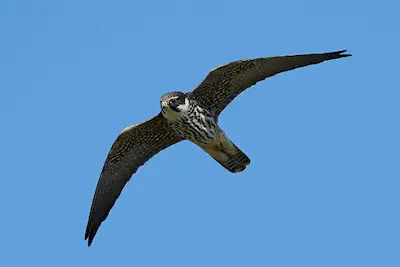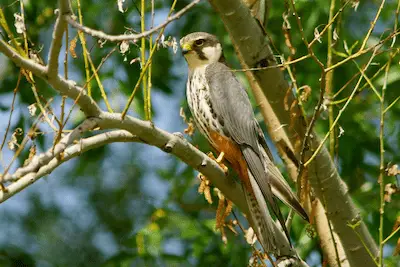Eurasian Hobby
(Falco subbuteo)
The Eurasian Hobby is a small falcon that catches its prey in the air with extremely well developed aerial hunting skills.

For instance, the Eurasian Hobby is the only European bird of prey that is capable of regularly catching Common Swifts, which can easily outfly every other raptor species.
Eurasian Hobbies are long distance migratory birds that routinely travel 10,000 km or more between their breeding grounds in Europe, and their wintering grounds in Africa.
While the overall population of the European Hobby is stable, it should be closely monitored, as it doesn’t do very well in landscapes with intensive industrial agriculture.
Eurasian Hobby facts
The Eurasian Hobby is most often seen gliding slowly back and forth over bodies of water or marshland, where it catches dragonflies on the wing. During the breeding season it is also a very skilled hunter of small birds, sometimes stooping down on them in the manner of a Peregrine.
Eurasian Hobby size
The Eurasian Hobby is a small falcon similar in size to the Eurasian Kestrel, although these two falcons found in Europe have different proportions as well as different behavior, which makes them easy to distinguish.
- Wingspan: 75-85 cm
- Length: 28-35 cm
- Weight: 176-285 g
While Eurasian Hobbies resemble Eleonora’s Falcon in coloring, they are smaller and have shorter wings than the latter. They also live in very different locations and habitats, making it unlikely that you’ll confuse them.
Appearance
A small falcon with a relatively short tail. Uniformly dark brown on top, with a light colored underside with brown speckles. The legs and the vent region under the tail are rufous colored.

In terms of proportions, the European Hobby is similar to a Peregrine Falcon, though significantly smaller, and with a more slender, narrow body and tail.
Sexual dimorphism
Similar to most European raptors, female Eurasian Hobbies are larger by about 10-15%, and also have slightly different coloring on their legs. While the males have uniformly rufous plumage on the legs, the females have rufous plumage with brown speckles. However, you need to be very close in order to spot this difference.
Lifespan
The maximum age recorded in the wild is 15 years.
Scientific name and taxonomy
The scientific name of the Eurasian Hobby is Falco subbuteo. Two subspecies are thought to exist, only one of which is present in Europe. Its closest relatives are the Eleonora’s Falcon (Falco eleonorae) and the Red-footed Falcon (Falco vespertinus) in Europe, and the Sooty Falcon (Falco concolor) in Africa and the Middle East.
Eurasian Hobby distribution
The Eurasian Hobby is found all over Europe, except for the northernmost parts in Scandinavia, Ireland and Russia. Outside of Europe, its range extends eastwards all the way to shores of the Pacific and Japan.
Eurasian Hobby habitat
The Eurasian Hobby prefers open country interspersed with woods and bodies of water. Avoids high altitudes. Often found close to water, although it also occurs in open country far away from water when it hunts birds. In addition to this, the European Hobby requires nests built by other birds (such as crows or other raptor species), since it doesn’t build its own nest.
Eurasian Hobby population size
The entire European population of Eurasian Hobbies is estimated to be between 70,000 and 120,000 pairs by BirdLife International, with almost half of those occurring in Russia (30,000 to 60,000 pairs). Coming second behind Russia is France, which has up to 9,500 breeding pairs.
Eurasian Hobby behavior
The most common behavior that Eurasian Hobbies show is gliding slowly to and fro over rivers, lakes and wetlands, patrolling for dragonflies. When a dragonfly is spotted, the Hobby accelerates or stoops down and catches it in midair.
Feeding and diet
During the breeding season, small birds become the main food source, with the main species depending on the location. In some areas, Hobby birds are known to feed on Common Swifts regularly, which is a testimony to their aerial hunting skills.
Outside of the breeding season, the main food source are insects, and the preferred foraging areas in Europe are along lakes, rivers, ponds, and marshes, where the European Hobby uses its superior flying skills to catch dragonflies in the air.
While wintering in Africa, one of the main food sources are swarming termites.
Breeding
Occupies old nests built by crows or buzzards as its own nest, and lays 2-4 eggs, which are incubated for 28 to 31 days. After hatching, the chicks stay in the nest for up to 35 days, and continue to be fed after they fledge. In fact, adult European Hobby birds were observed feeding their fledged chicks until just before the start of migration.
Migration
The Eurasian Hobby is a strict migratory bird that spends the winter in Africa south of the Sahara desert. This makes a lot of sense, given that insects form the largest part of their diet outside of the breeding season.
During migration and while wintering, Hobby birds avoid dense forests and prefer open landscapes. As mentioned above, they favor termites as a food source, and often winter in regions with large termite populations.
European Hobby conservation status
The overall population of the European Hobby appears to be stable, which is why BirdLife International has classified its conservation status as “Least Concern”. However, due to its extremely broad range, many populations of the European Hobby are not very well monitored, which means it’s hard to tell if they are declining.
Threats
The biggest threat to Eurasian Hobbies is destruction of habitat due to intensification of agricultural practices. This is because its main food species during the breeding season, including larks and swallows, don’t thrive in areas with industrial farming practices. In addition to this, the Eurasian Hobby also requires suitable nests that it inherits from other bird species, most notably crows. Where these are not available, the Hobby is unable to breed.
